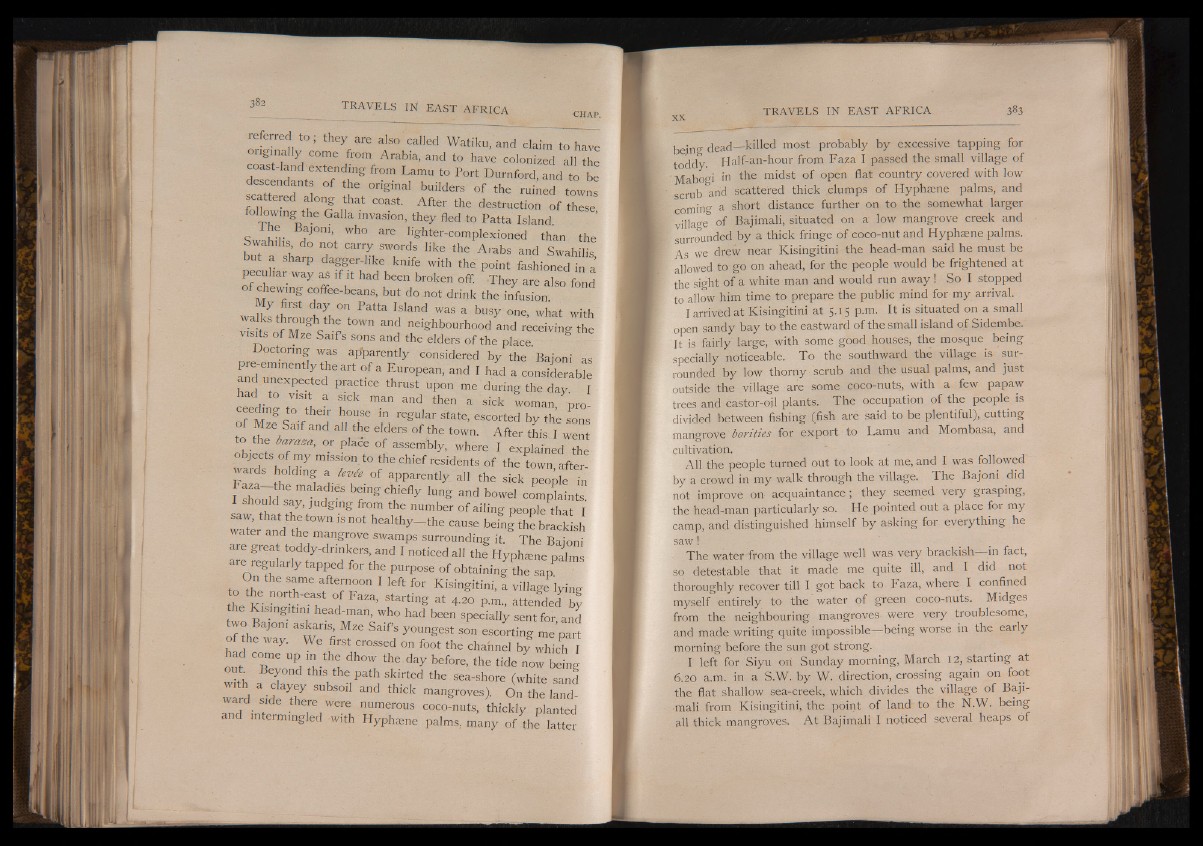
eferred to ; they are also called Watiku, and claim to have
originahy come from Arabia, and to have colonized all the
coast-land^extending from Lamu to Port Durnford, and to be
descendants of the original builders of the ruined towns
scattered along that coast. After the destruction of these
following die Galla invasion, they fled to Patta Island.
e Bajom, who are lighter-complexioned than the
Swahihs do not carry swords like the Arabs and Swahihs
a sharp dagger-like knife with the point fashioned in a
peculiar way aS if it had been broken off. They are also fond
of chewing coffee-beans, but do not drink the infusion
My fin* day on Patta Island was a busy one, what with
walks through the town and neighbourhood and receiving the
visits of Mze Saifs sons and the elders of the place.
octormg was apparently considered by the Baioni as
pre-eminently the art of a European, and I had a considerable
and unexpected practice thrust upon me during the day. I
had to visit a sick man and then a sick toman pro
Cf eMn g ct0 rtheir hOUSe in re^ lar stete, escorted by t L sJns
to alI, the elders of the town. After this. I went
to the baraza, or place of assembly, where I explained the
jects of my mission to the chief residents of the town afterwards
holding a levte of apparently all the sick people in
F a za - th e maladies being chiefly lung and bowel compkints
should say, judging from the number of ailing people that I
water aa„ d ih e 0W" “ 1,01 hea' th> '- th<! ater and the mangrove swamps surroOun-"d#in «g i„t.g tThhee b rBaacikoinshi
are great toddy-drinkers, and I noticed all the Hyphame palms
are regularly tapped for the purpose of obtaining the sap
On the same afternoon I left for Kisingitini, a village lyme
o the north-east of Faza, starting at 4.20 p.m., attended by
the Kisingitini head-man, who had been specially sent for and
two Bajom askans Mze Saifs youngest son escorting me’part
of the way. We first crossed on foot the channel by which I
had come up in the dhow the day before, the tide now b e k g
out Beyond this the path skirted the sea-shore (white sand
w id s i d t r SUbSOil and ,hick A ,he l Z
ward side there were numerous coco-nuts, thickly planted
and intermingled with Hyphame palms, many of the latte.
being dead—killed most probably by excessive tapping for
toddy. Half-an-hour from Faza I passed the small village of
• jy[aw i in the midst of open flat country covered with low
scrub and scattered thick clumps of Hyphaene palms, and
coming a short distance further on to the somewhat larger
I village of Bajimali, situated on a low mangrove creek and
I surrounded by a thick fringe of coco-nut and Hyphaene palms.
I a s we drew near Kisingitini the head-man said he must be
I allowed to go on ahead, for the people would be frightened at
the sight of a white man and would run away! So I stopped
. to allow him time to prepare the public mind for my arrival.
I arrived at Kisingitini at 5.15 p.m. It is situated on a small
open sandy bay to the eastward of the small island of Sidembe.
It is fairly large, with some good houses, the mosque being
specially noticeable. To the southward the village is surrounded
by low thorny scrub and the usual palms, and just
outside the village are some coco-nuts, with a few papaw
trees and castor-oil plants. The occupation of the people is
divided between fishing (fish are said to be plentiful), cutting
mangrove bovitiss for export to Famu and Mombasa, and
cultivation.
All the people turned out to look at me, and I was followed
by a crowd in my walk through the village. The Bajoni did
not improve on acquaintance; they seemed very grasping,
the head-man particularly so. He pointed out a place for my
camp, and distinguished himself by asking for everything he
saw!
The water from the village well was very brackish— in fact,
so detestable that it made me quite ill, and I did not
thoroughly recover till I got back to Faza, where I confined
myself entirely to the'water of green coco-nuts. Midges
from the neighbouring mangroves were very troublesome,
and made writing quite impossible— being worse in the eaily
morning before the sun got strong.
I left for Siyu on Sunday morning, March 12, starting at
6.20 a.m. in a S.W. by W. direction, crossing again on foot
the flat shallow sea-creek, which divides the village of Bajimali
from Kisingitini, the point of land to the N.W. being
all thick mangroves. At Bajimali I noticed several heaps of